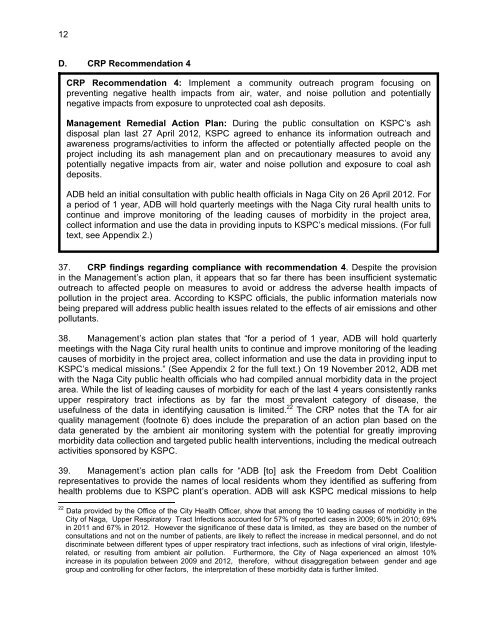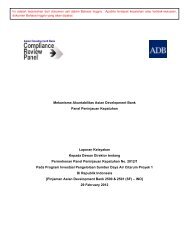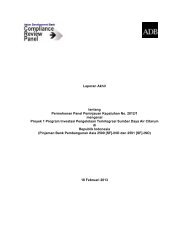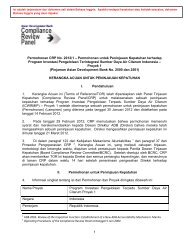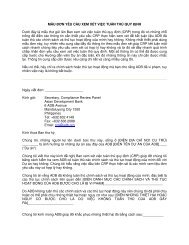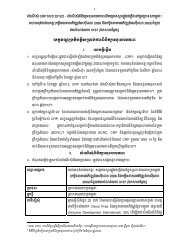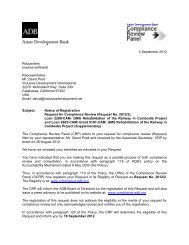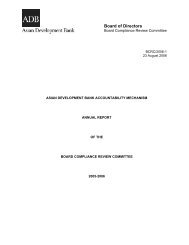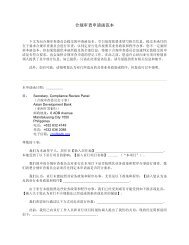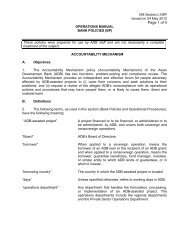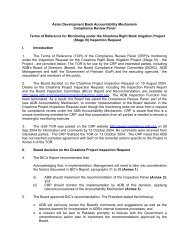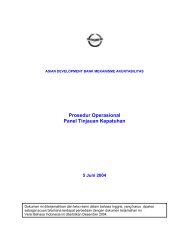Annual Monitoring Report - ADB Compliance Review Panel - Asian ...
Annual Monitoring Report - ADB Compliance Review Panel - Asian ...
Annual Monitoring Report - ADB Compliance Review Panel - Asian ...
You also want an ePaper? Increase the reach of your titles
YUMPU automatically turns print PDFs into web optimized ePapers that Google loves.
12<br />
D. CRP Recommendation 4<br />
CRP Recommendation 4: Implement a community outreach program focusing on<br />
preventing negative health impacts from air, water, and noise pollution and potentially<br />
negative impacts from exposure to unprotected coal ash deposits.<br />
Management Remedial Action Plan: During the public consultation on KSPC’s ash<br />
disposal plan last 27 April 2012, KSPC agreed to enhance its information outreach and<br />
awareness programs/activities to inform the affected or potentially affected people on the<br />
project including its ash management plan and on precautionary measures to avoid any<br />
potentially negative impacts from air, water and noise pollution and exposure to coal ash<br />
deposits.<br />
<strong>ADB</strong> held an initial consultation with public health officials in Naga City on 26 April 2012. For<br />
a period of 1 year, <strong>ADB</strong> will hold quarterly meetings with the Naga City rural health units to<br />
continue and improve monitoring of the leading causes of morbidity in the project area,<br />
collect information and use the data in providing inputs to KSPC’s medical missions. (For full<br />
text, see Appendix 2.)<br />
37. CRP findings regarding compliance with recommendation 4. Despite the provision<br />
in the Management’s action plan, it appears that so far there has been insufficient systematic<br />
outreach to affected people on measures to avoid or address the adverse health impacts of<br />
pollution in the project area. According to KSPC officials, the public information materials now<br />
being prepared will address public health issues related to the effects of air emissions and other<br />
pollutants.<br />
38. Management’s action plan states that “for a period of 1 year, <strong>ADB</strong> will hold quarterly<br />
meetings with the Naga City rural health units to continue and improve monitoring of the leading<br />
causes of morbidity in the project area, collect information and use the data in providing input to<br />
KSPC’s medical missions.” (See Appendix 2 for the full text.) On 19 November 2012, <strong>ADB</strong> met<br />
with the Naga City public health officials who had compiled annual morbidity data in the project<br />
area. While the list of leading causes of morbidity for each of the last 4 years consistently ranks<br />
upper respiratory tract infections as by far the most prevalent category of disease, the<br />
usefulness of the data in identifying causation is limited. 22 The CRP notes that the TA for air<br />
quality management (footnote 6) does include the preparation of an action plan based on the<br />
data generated by the ambient air monitoring system with the potential for greatly improving<br />
morbidity data collection and targeted public health interventions, including the medical outreach<br />
activities sponsored by KSPC.<br />
39. Management’s action plan calls for “<strong>ADB</strong> [to] ask the Freedom from Debt Coalition<br />
representatives to provide the names of local residents whom they identified as suffering from<br />
health problems due to KSPC plant’s operation. <strong>ADB</strong> will ask KSPC medical missions to help<br />
22 Data provided by the Office of the City Health Officer, show that among the 10 leading causes of morbidity in the<br />
City of Naga, Upper Respiratory Tract Infections accounted for 57% of reported cases in 2009; 60% in 2010; 69%<br />
in 2011 and 67% in 2012. However the significance of these data is limited, as they are based on the number of<br />
consultations and not on the number of patients, are likely to reflect the increase in medical personnel, and do not<br />
discriminate between different types of upper respiratory tract infections, such as infections of viral origin, lifestylerelated,<br />
or resulting from ambient air pollution. Furthermore, the City of Naga experienced an almost 10%<br />
increase in its population between 2009 and 2012, therefore, without disaggregation between gender and age<br />
group and controlling for other factors, the interpretation of these morbidity data is further limited.


